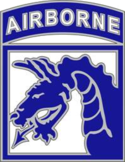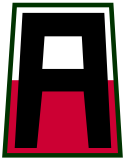United States Army Forces Command
| United States Army Forces Command | |
 Ärmmärke för FORSCOM | |
| Information | |
|---|---|
| Officiellt namn | FORSCOM |
| Datum | 1993– |
| Land | |
| Försvarsgren | |
| Del av | USA:s armédepartement |
| Föregångare | se lista i artikel |
| Ingående delar | se lisa i artikeln |
| Högkvarter | Fort Bragg |
| Förläggningsort | Fayetteville, North Carolina, USA |
| Webbplats | www.army.mil/FORSCOM |
| Tjänstetecken | |
| Distinctive Unit Insignia |  |
USA:s Army Forces Command (FORSCOM) är det största huvudkommandot i USA:s armé. FORSCOM har sitt högkvarter på Fort Bragg i North Carolina och består av mer än 750 000 aktiva soldater, amerikanska arméreserven och ur arménationalgardet.
Dess uppgift att upprätthålla slagkraftiga och stridsberedda förband inom armén för att kunna överföras till försvarsgrensövergripande befälhavare när behov uppstår enligt befallning från ovan.[1][2]
FORSCOM har haft det nuvarande namnet sedan 1993, men organisationen har funnits under olika namn sedan USA gick in i andra världskriget.
Föregångare
- U.S. Army Ground Forces (1942–1948)
- U.S. Army Field Forces (1948–1955)
- Continental Army Command (1955–1973)
- U.S. Army Forces Command (1973–1987)
- U.S. Forces Command (1987–1993)
Under 2011 flyttade FORSCOM sitt högkvarter från Fort McPherson i Georgia, som därefter lades ned, till Fort Bragg.
Ingående förband och enheter
| Symbol | Namn | Förkortning | Basering | Funktion | Not |
 | United States Army Reserve Command | USARC | Fort Bragg, North Carolina | Kommando för den federala arméreserven | |
 | First United States Army | Rock Island Arsenal, Illinois | Första fältarmén, inrättad 1918 | ||
 | III Corps | Fort Hood, Texas | Tredje armékåren | ||
 | V Corps | Fort Knox, Kentucky | Femte armékåren. Återinförd under 2020. | ||
 | XVIII Airborne Corps | Fort Bragg, North Carolina | Armékår med luftburna styrkor | ||
 | Security Force Assistance Command | SFAC | Fort Bragg, North Carolina | Kommando inrättat under 2018 för militära rådgivare till allierade eller vänligt sinnade stater i säkerhetssamarbete eller väpnad konflikt | |
 | 20th CBRNE Command | CBRNE | Aberdeen Proving Ground, Maryland | CBRN-krigföring | |
 | 32nd Army Air and Missile Defense Command | 32nd AAMDC | Fort Bliss, Texas | Taktiskt luftvärn och robotförsvar | |
 | National Training Center | NTC | Fort Irwin, Kalifornien | Stort övningsområde för krigsspel i ökenmiljö med B-styrka | |
 | Joint Readiness Training Center | JRTC | Fort Polk, Louisiana | Stort övningsområde för krigsspel i djungelliknande miljö med B-styrka |
Se även
- Air Combat Command (motsvarande organisation i USA:s flygvapen)
- United States Fleet Forces Command (motsvarande organisation i USA:s flotta)
- United States Marine Corps Forces Command (motsvarighet i USA:s marinkår)
- Space Operations Command (motsvarighet i USA:s rymdstyrka)
Referenser
- Den här artikeln är helt eller delvis baserad på material från engelskspråkiga Wikipedia, United States Army Forces Command, tidigare version.
Noter
- ^ ”About” (på engelska). U.S. Army Forces Command. https://www.army.mil/FORSCOM#org-about. Läst 4 augusti 2021.
- ^ ”Department of the Army” (på engelska). United States Government Manual. https://www.usgovernmentmanual.gov/Agency?EntityId=3GJO1NbMMTA=&ParentEId=tv4LVSeIL00=&EType=/sbLHImeIYk=. Läst 4 augusti 2021. ”Headquartered at Fort Bragg, NC, U.S. Army Forces Command (FORSCOM) prepares conventional forces to provide a sustained flow of trained and ready land power to combatant commanders in defense of the Nation at home and abroad.”
Externa länkar
- www.army.mil/FORSCOM
 Wikimedia Commons har media som rör United States Army Forces Command.
Wikimedia Commons har media som rör United States Army Forces Command.
Media som används på denna webbplats
20th CBRNE distinctive insignia.
Shoulder sleeve insignia of the III Corps.
Sammanfattning
A blue caltrop with three points that lie on a circle of 1 1/2 inch radius with a white triangle in the center with points that lie on a circle of 3/8 inch radius. The design is enclosed by a 1/8 inch Army green border.
Symbolism
The triangular design represents the numerical designation of the corps. The blue and white are the authorized colors used in distinguishing flags to represent corps.
Background
United States Army Reserve Command (USARC) SSI, Shoulder Sleeve Insignia, Shoulder Patch
Shoulder Sleeve Insignia of the National Training Center.
- Description
- A nine-sided green device with one point down in base, 2 7/16 inches in height overall, bearing three arrowheads with points converging at center, a yellow arrow at the top, blue at left and red at the right, all within a 1/8 inch yellow border.
- Symbolism
- The colors are adapted from the coat of arms of the National Training Center and refer to Armor, Infantry and Artillery, the combat arms branches brought together to train as combined arms teams and task forces at the National Training Center. The arrowheads signify a concentration of training and education. Though they converge from various angles, they form a cohesive unit signifying the mission and capabilities of the National Training Center.
- Background
- The insignia was approved on 23 Apr 1982.
w:U.S. Army's, Joint Readiness Training Center and Joint Readiness Training Center Operations Group w:distinctive unit insignia
1st US Army Shoulder Sleeve Insignia
U.S. Army's Security Force Assistance Brigades shoulder sleeve insignia (SSI)
SSI design: The shoulder sleeve is a shield with a sword, spearhead and stars. The Tab will have the word "ADVISOR" on it. The advisor tab is a unit tab, not a skill tab. The specialized advisor mission is the reason for the tab. The shape of the shield and sword are modeled after the Military Assistance Command-Vietnam (MAC-V) insignia to convey a similar mission and heritage. The arrowhead shape alludes to leadership and direction, as well as rapid deployability. The sword conveys force, whether it be offense, defense or assistance. The thirteen stars reflect the "Glory" crest in the coat of arms of the United and symbolize the thirteen original states and the Army Mission patch worn by Military Assistance Advisory Groups. The colors red and blue denote security and authority. The color white highlights the uniqueness of the brigades and their specialized missions. The color gold exemplifies excellence and expertise.
Det är enkelt att lägga till en ram runt den här bilden













